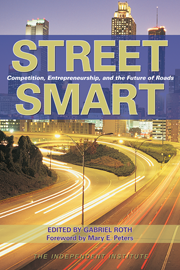To reduce traffic congestion, some argue that highly subsidized light rail transit is a good solution. It is not uncommon to hear advocates claim that a light rail (LRT) line can carry as much traffic as an eight-lane freeway.
Light rail trains are big compared to private automobiles (the main vehicle using the freeway). If full and running at maximum capacity, LRT could, theoretically, carry more people than the multiple automobiles using a freeway.
This theoretical advantage for LRT is being used to support the notion that these trains ought to be added to freeway medians to expand urban traffic capacity. So persuaded of the rightness of this contention are LRT advocates, that the Portland City Council may block a much-needed Interstate Highway bridge over the Columbia River between Oregon and Washington if LRT is not included in the design.
Critics of LRT point out that it is not theoretical capacity that is crucial, but actual ridership and the cost incurred to garner this ridership. National figures indicate that on average, LRT carries about 5,000 people per track-mile per day, while urban freeways carry over 20,000 per lane-mile per day. So, in actual numbers of people served, freeways seem to handle over four times as much traffic as LRT does.
Well, LRT handles less traffic, but how about cost? When we consider cost, the case for LRT is further weakened. In an effort to weigh the alternatives for increasing capacity in freeway corridors, the Arizona Department of Transportation (AzDOT) Research Center used one of the Phoenix region’s freeways (State Route 51) as a "case study." (Multimodal Optimization of Urban Freeway Corridors?)
In this case study, several alternatives were evaluated: HOV lanes (high-occupancy vehicle), HOT lanes (high-occupancy vehicles free, others toll), general purpose (GP) lanes, bus rapid transit (BRT) on the HOV lanes, and LRT. A cost per person-mile for each alternative was calculated based on ridership figures (supplied by the local metropolitan planning agency) and vehicle traffic volumes (provided by the AzDOT).
The costs included the cost of construction, operation, and maintenance incurred by the public-sector agencies for each alternative. Inasmuch as the roadway—unlike LRT—can also accommodate freight-carrying trucks, this comparison is the most favorable possible for LRT.
Costs per person-mile were calculated two different ways. The first allocated all costs to all traffic. This generated a comprehensive comparison for all the alternatives. The second method focused on a peak-period comparison, in order to address the assertion that the extra capacity—whether for road or rail—wouldn’t be necessary for off-peak traffic volumes. In this case, the fixed costs were allocated only to the peak-period traffic.
The analysis showed that placing a rail transit line in the freeway median would be the least cost-effective alternative for moving traffic in this corridor. Even with the abutting GP lane traffic lowering the average cost per person-mile for LRT to 36 cents during the peak and 16 cents for all-day (the average cost per person-mile for LRT in the United States is around $1.50), the LRT option was still the most expensive—by far. In contrast, every roadway-based option was much more cost-effective. The HOT lane had the lowest cost per person-mile (3 cents at the peak period and 1 cent for all-day).
It is clear that the space in the medians of urban freeways is too precious to be wasted on LRT. Such space would produce more congestion-mitigating benefits if used to accommodate automobiles and buses. Displacing space that could be used for a roadway lane with a rail line would be a costly error.








